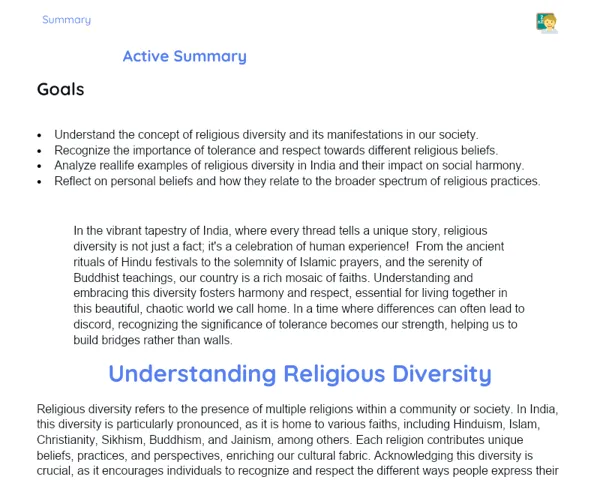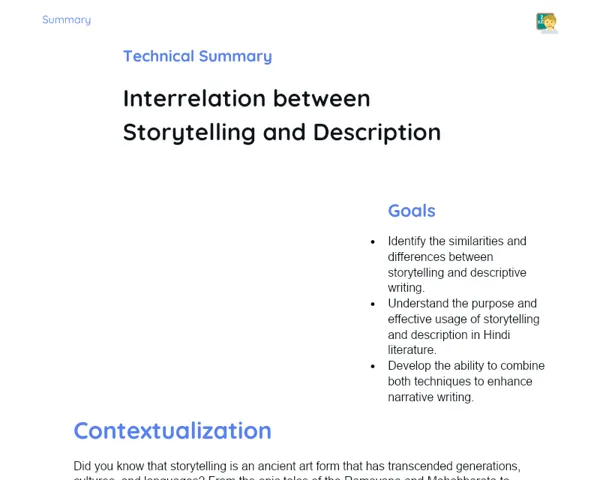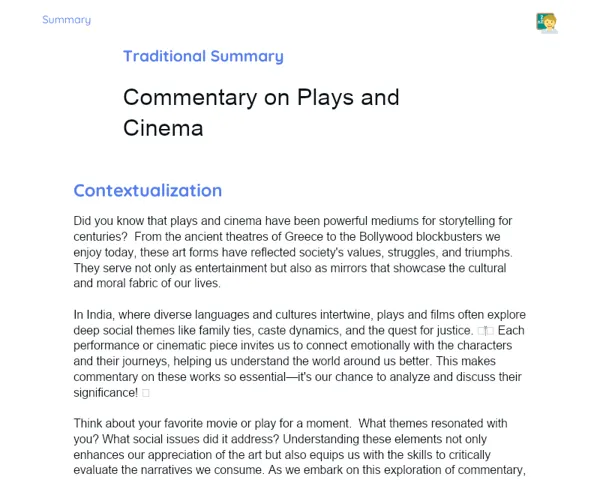Traditional Summary | Adding Emotion to Poetry
Contextualization
Did you know that poetry has been an integral part of Indian culture for centuries? From the heartfelt verses of Kabir and Ghalib to the rhythmic couplets of modern poets, poetry allows us to express our deepest emotions and thoughts. 🌟 In our day-to-day lives, we experience a myriad of emotions – joy, sadness, anger, and love – and poetry provides a beautiful platform to convey these feelings. Imagine writing a poem that captures a moment of happiness or the bittersweet feeling of nostalgia! Isn’t that magical? ✨
Adding emotion to poetry is not just about putting words on paper; it's about painting pictures with your words that resonate with your heart and soul. When you infuse emotion into your verses, you invite your readers into your world. Think about how a simple word can evoke powerful images and feelings. Art, much like life, is all about connection, and poetry helps us forge those connections with others in a unique way. 🌈
In our lesson today, we’ll explore how you can bring out the emotions in your poetry and engage your audience. Poetry can be a voice for the unheard, a mirror for our society, and a canvas for our emotions. So, let’s embark on this poetic journey together! Get ready to unleash the poet within you and express those feelings like never before! 🎉
To Remember!
Imagery
Imagery refers to the use of vivid and descriptive language that appeals to our senses, helping to create mental pictures in the minds of readers. In poetry, strong imagery can evoke feelings of joy, sadness, or nostalgia, allowing readers to connect deeply with the emotions expressed. For instance, describing a sunset with phrases like 'the fiery orange sun dipped beneath the horizon, painting the sky in shades of rose' uses imagery to not only visualize the scene but also to convey the beauty and tranquility of the moment. This connection is vital as it allows us to feel what the poet feels, bridging the gap between the writer's heart and the reader's soul.
-
Imagery engages the senses: Effective imagery paints a picture that engages sight, sound, smell, touch, and taste, making the poem more relatable and powerful.
-
Enhances emotional connection: When readers can visualize a moment, they are more likely to resonate with the emotions tied to that moment, making the poem impactful.
-
Creates unique interpretations: Each reader's personal experiences shape their understanding of imagery, allowing for multiple interpretations and deeper engagement with the poem.
Tone
Tone is the poet's attitude toward the subject or audience, conveyed through their choice of words and style. It can be playful, serious, sarcastic, or sentimental, influencing how the reader perceives the poem. For example, a poem about loss can have a mournful tone that envelops the reader in sadness or a reflective tone that invites contemplation. Understanding the tone is crucial as it sets the mood for the poem and guides the reader’s emotional response. When you master tone, you can steer your audience towards the feelings you wish to convey, significantly enhancing your poetic expression.
-
Establishes mood: The tone of a poem creates the emotional backdrop against which the reader interprets the words.
-
Influences interpretation: A change in tone can change how a specific line or phrase is understood, adding layers of meaning to the poetry.
-
Reflects the poet's voice: The tone often reflects the personal style of the poet, allowing their unique personality to shine through.
Symbolism
Symbolism is the use of symbols to signify ideas and qualities beyond their literal sense. In poetry, symbols can represent emotions, themes, or concepts, allowing poets to convey complex ideas succinctly. For instance, a dove might symbolize peace, while a storm could represent turmoil. By using symbols, poets can infuse their works with deeper meaning, encouraging readers to think critically about the messages being communicated. This element adds a rich layer to poetry, making it a profound tool for exploring and expressing emotions.
-
Conveys deeper meaning: Symbols allow poets to express complex emotions and ideas in a compact form, making their work more impactful.
-
Encourages critical thinking: When readers identify symbols, they are prompted to explore their significance, leading to a more engaging reading experience.
-
Cultural relevance: Many symbols draw from cultural references, allowing poets to connect with their audience on a deeper level through shared meanings.
Key Terms
-
Imagery: Language that creates vivid pictures in the reader's mind, appealing to the senses.
-
Tone: The attitude of the poet towards the subject, conveyed through word choice and style.
-
Symbolism: The use of symbols to represent larger ideas or themes in poetry.
Important Conclusions
In today's lesson, we uncovered the magic of adding emotion to poetry through the use of imagery, tone, and symbolism. These elements are not just literary devices; they are the heart and soul of your poems. By painting vivid pictures with your words, setting the mood with your tone, and using symbols to convey deeper meanings, you can create poetry that resonates with readers and reflects your experiences. Remember, poetry is a personal journey, and through it, you can express emotions that connect you with others in powerful ways. 🌟
Think about how poetry can mirror your own life experiences, from the joy of playing with friends to the sadness of losing a loved one. The beauty of poetry lies in its ability to capture the feelings that words alone sometimes fail to express. As you continue to explore your creative side, remember that each poem you write is an opportunity to share a piece of your heart with the world. Keep discovering the poet within you and embrace the emotions that flow through your verses! ✨
Study Tips
-
Read poems from various poets to observe how they use imagery, tone, and symbolism. Pay attention to how these elements convey emotions.
-
Practice writing short poems about your day-to-day experiences and focus on incorporating strong imagery and emotional tone to connect with your readers.
-
Share your poems with friends or family and discuss the emotions they feel while reading them, which can help you understand the impact of your poetic choices.



